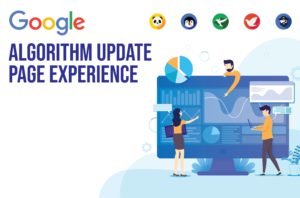 As we dive headfirst into the new year, it makes sense that we’d look ahead to what Google has planned for 2021. While we don’t always know what Google has in store, we do know that the Page Experience algorithm update is slated to roll out in May of this year.
As we dive headfirst into the new year, it makes sense that we’d look ahead to what Google has planned for 2021. While we don’t always know what Google has in store, we do know that the Page Experience algorithm update is slated to roll out in May of this year.
We’re not always informed when an update is set to occur (or even when one has already happened!), so this provides us with a unique opportunity for growth. Since algorithm updates have been known to shake up search rankings, it’s important that we pay attention to what Google is looking for and make pertinent adjustments to our sites in advance. Here’s what you should know about this algorithm update and how you can prepare your website.
Algorithm updates actually happen thousands of times every year over at Google. Most users won’t know when these updates happen — and business owners may realize something’s amiss only when their search rankings drop as a result of the rollout.
Google has been generous enough to let us know well in advance about the Page Experience algorithm update, as well as what kinds of factors will be considered when evaluating websites. Essentially, both Google and web users will react positively to web pages that load quickly on any device and are free of performance issues, site errors, obtrusive pop-ups, and security vulnerabilities. In the next section, we’ll outline just some of the factors that you should discuss with your digital marketing provider or website developer to ensure your site meets all of the criteria.
But why is it so important to adhere to Google’s recommendations? For one thing, the way Google evaluates sites can have a big impact on how readily yours appears in search engine results. If you ignore Google’s guidelines, your site may be penalized or experience a significant drop in rankings — and that can impact your website traffic and sales for the foreseeable future. However, it’s important to keep the big picture in mind. It’s not just about pleasing the Powers That Be at Google; it’s really about making sure web users can easily access the information they need. By creating a consistent experience for online visitors, you’ll make it easier for them to become customers and for them to associate positive feelings with your brand.
With all that in mind, you might be wondering what you should focus on to prepare for this update. Here are just a few of the considerations Google will take into account.
Loading Speed and Performance: At a bare minimum, you should check to make sure that there are no broken links or navigation errors anywhere on your site. You should also make every effort to speed up the time it takes for pages to load. Specifically, pay attention to Largest Contentful Paint (LCP), a Core Web Vital that measures how long it takes for a page’s largest piece of content to load. You’ll be in good shape if this comes in at under 2.5 seconds.
Visual Stability: Another one of Google’s Core Web Vitals is Cumulative Layout Shift (CLS), which measures instances of unexpected jumps or shifts in a page’s layout. Web users want a seamless experience when they’re reading a post or information about your services, so a disruption in the layout can be jarring and frustrating. Your CLS score should be 0.1 or less for best results.
Interactivity: Google also cares about interactivity delays, which is why First Input Delay (FID) is the third of its Core Web Vitals. Ideally, the amount of time between when a page first starts to load and a user is able to interact with the page should be less than 100 milliseconds. You’ll want to make every effort to address this issue before the algorithm update, too.
Mobile-Friendliness: The need for mobile-friendly websites should come as no surprise. After all, half of all web traffic now comes from mobile users. Your site’s design should be responsive and pose no issues for mobile viewing (like interstitials or navigation problems). There are plenty of ways to assess how mobile-friendly your site is — and since it’s already something we know Google values, now is the time to address it.
Security: Site security is another issue Google prioritizes — and it’s easy to understand why. No one wants to use a site that’s potentially vulnerable to hackers or other malicious behavior. Even if you don’t collect any sensitive information from customers, you’ll need an SSL certificate and must make every effort to protect the pages on your site.
It’s not always easy to know what Google expects to see. But now that you know the Page Experience basics, you can get to work on preparing your site for May’s algorithm rollout.
In the fast-evolving world of real estate, leadership is more crucial than ever. Chris Heller, a prominent figure in the industry, emphasizes the importance of decision-making and innovation in proptech. His insights reveal that a passionate mindset, effective team building, and strategic risk management are essential for success. By exploring Heller’s perspectives, you will gain
We’ve had the privilege of knowing and working with Nick for over a decade. He’s a successful entrepreneur and real estate investors whose done over 1,500 deals, mostly with PPC. He’s passionate about sharing his expertise and helping others achieve similar success through his specialized training program the 7 Figure Cartel. Nick’s journey has involved